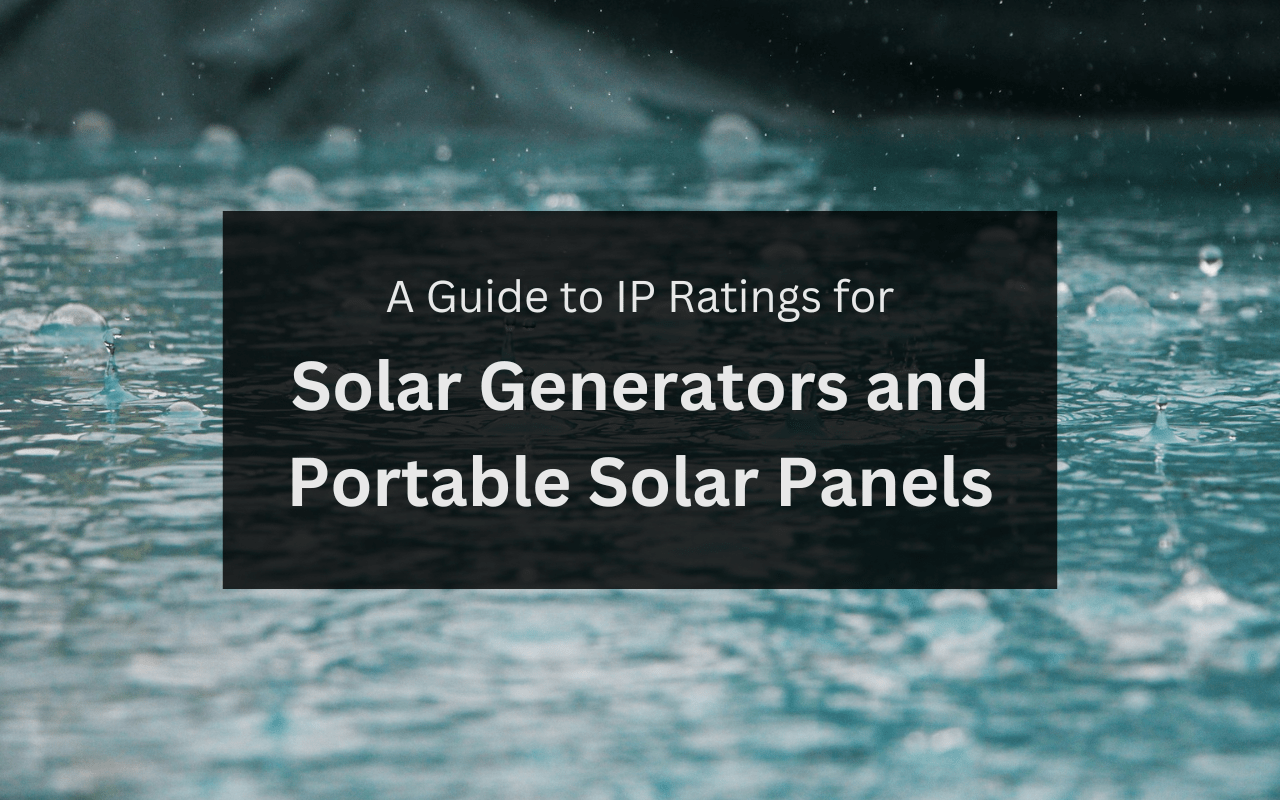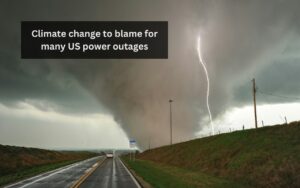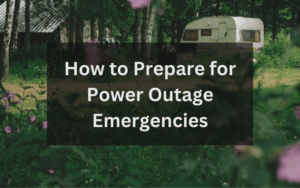Understanding IP ratings
IP ratings, or Ingress Protection ratings, tell you how well electrical devices like solar generators resist intrusion from foreign objects and water. Developed by the International Electrotechnical Commission (IEC), these ratings are a standard way to measure protection levels.
Each IP rating has two digits: the first number describes the device’s protection against solids like dust, ranging from 0 (no protection) to 6 (dust-tight). The second digit rates protection against liquids, from 0 (no protection) to 9 (protects against hot and high-pressure water jets from different angles). Knowing the IP rating of a solar generator can help you understand how it will perform in different environmental conditions, ensuring that you choose a device suitable for your needs, for example in extreme weather conditions.
It is important to note that while IP ratings offer a standard measure of protection, manufacturers sometimes advise against conditions that IP ratings claim to withstand. We will discuss this in more detail below.
What does the first IP number mean?
The first number in an IP rating measures how well an electrical device, such as a solar generator, portable power station, or portable solar panel, is protected against solid objects and particulate matter. The scale of the first number ranges from 0 to 6. It helps you determine how well your solar devices are protected against solid particles like dust and sand, which are common in outdoor settings like beaches and deserts.
Here’s a clearer breakdown of what each level means for these devices:
- IP0_: No special protection against any solids.
- IP1_: Protects against objects larger than 50mm, like accidental touch by a hand.
- IP2_: Protects against objects larger than 12.5mm, such as fingers.
- IP3_: Offers protection against objects larger than 2.5mm, which includes larger grains of sand, protecting the device when used in sandy environments.
- IP4_: Guards against objects larger than 1.0mm, such as fine sand, making the device suitable for use in most outdoor conditions without the intrusion of small particles.
- IP5_: Dust-protected, which means dust cannot enter in an amount sufficient to interfere with satisfactory operation. Ideal for environments like workshops or outdoor areas with significant dust.
- IP6_: Completely dust-tight, providing full protection against dust and sand, perfect for use in harsh environments like deserts or industrial sites.
What does the second IP number mean?
The second digit in an IP rating explains how well an electrical device is protected against various forms of moisture, from light splashes to full underwater submersion. This is particularly important for devices used outdoors or in varied environments where contact with water is likely, such as in the rain, during fishing, or on a boat.
Here’s what each number means:
- IP_0: Offers no protection against water. Using this device near any water source is very risky and not recommended.
- IP_1: Protected against vertically falling water droplets, such as light rain, for a limited time.
- IP_2: Can withstand water droplets falling at a 15-degree angle. This covers light rain when the device is slightly tilted.
- IP_3: Resistant to spraying water, meaning it can handle light rain or sprays from any direction up to 60 degrees from vertical.
- IP_4: Protected against splashing water from any direction, suitable for more general outdoor use where splashes are a concern.
- IP_5: Can resist low-pressure water jets from any direction. This is suitable for use in environments where hose cleaning might occur.
- IP_6: Safeguards against powerful water jets. This level is suitable for severe outdoor conditions, including heavy rain and sea spray.
- IP_7: Protected against the effects of temporary immersion in water up to 1 meter deep for up to 30 minutes, ideal for accidental drops in water or sudden heavy downpours.
- IP_8: Offers protection against continuous submersion in water beyond 1 meter, where conditions are specified by the manufacturer – excellent for marine or flooded conditions.
- IP_9: Resistant to high pressure and high temperature water jets, providing the highest level of waterproofing available.
Table of IP ratings
IP ratings table
| 1st number: solids | 2nd number: water | ||
| 0 | No protection | 0 | No protection |
| 1 | Protected against solid foreign objects of 50mm diameter and greater | 1 | Protected against vertically falling water drops |
| 2 | Protected against solid foreign objects of 12.5mm diameter and greater | 2 | Protected against vertically falling water drops when enclosure tilted up to 15° |
| 3 | Protected against solid foreign objects of 2.5mm diameter and greater | 3 | Protected against spraying water |
| 4 | Protected against solid foreign objects of 1.0mm diameter and greater | 4 | Protected against splashing water |
| 5 | Dust-protected | 5 | Protected against water jets |
| 6 | Dust-tight | 6 | Protected against powerful water jets |
| 7 | Protected against the effects of temporary immersion in water | ||
| 8 | Protected against the effects of continuous immersion in water | ||
| 9 | Protected against high pressure and high temperature water jets | ||
Common IP ratings in portable power stations and solar panels
Solar generators, portable solar panels, and portable power stations often have IP ratings specified on the product’s website. The presence of these ratings (or indeed, the absence) is essential for determining their durability and suitability for outdoor environments.
However, it is important to note that you should still take precautions against splashes or rainfall, despite the presence of an IP rating. For example, whilst many of BLUETTI’s portable solar panels have an IP65 rating, they still specify that they should not be exposed to rainfall. While this is rather contradictory to the official IP ratings – as the IEC tells us an IP_5-rated appliance can “resist low-pressure water jets from any direction” – it is nevertheless important to heed in the context of warranty validity.
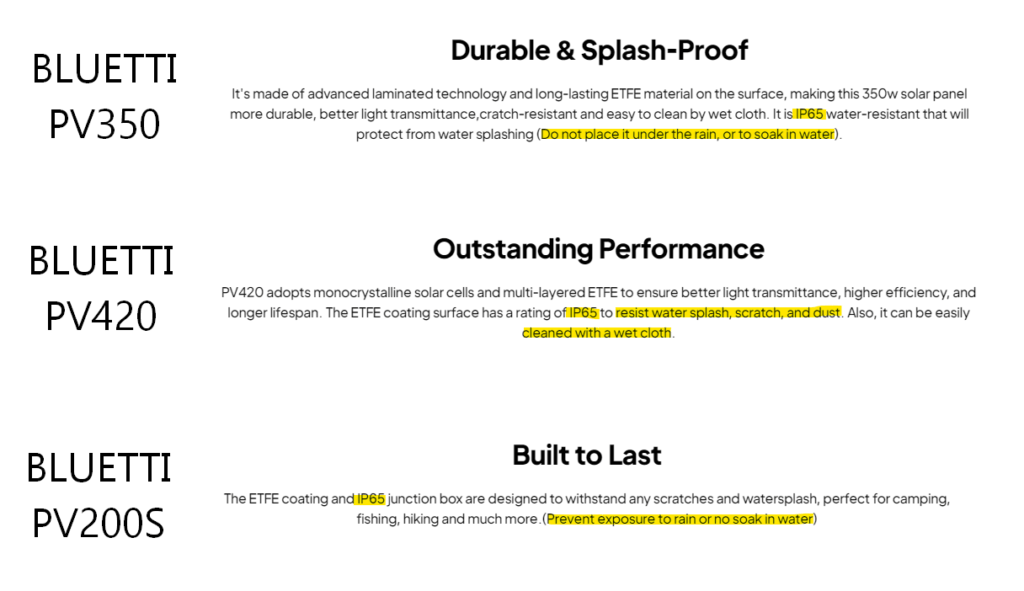
Furthermore, you should assume that if a product does not have an IP rating specified on its product page (or in the specifications table), it does not have any official dustproof or waterproof rating.
With that said, let’s take a look at some of the comment IP ratings we see in different solar products.
IP ratings for portable power stations
The most common IP rating we tend to see in portable power stations is IP65. This rating means they are (theoretically) dust-tight and protected against water jets, making them suitable for outdoor use where exposure to elements like rain and dust is likely.
Some brands offer waterproof bag accessories for their portable power stations, which makes them suitable for outdoor use in the rain, even if the power station itself doesn’t have a specified IP rating – or even if it does. These can also be useful for portability, as they often make carrying the power stations even easier.
IP ratings for portable solar panels
Checking the IP rating is arguably even more important when it comes to choosing portable solar panels, since these solar panels are designed for outdoor use and obviously cannot be shielded with a waterproof cover or bag while capturing sunlight. As an example, at the time of writing, all of EcoFlow’s portable solar panels have an IP rating of IP68, which makes them suitable for the majority of outdoor activities. (That is assuming that you’re not going to be shooting high-pressure, hot water jets at them from multiple different angles.)
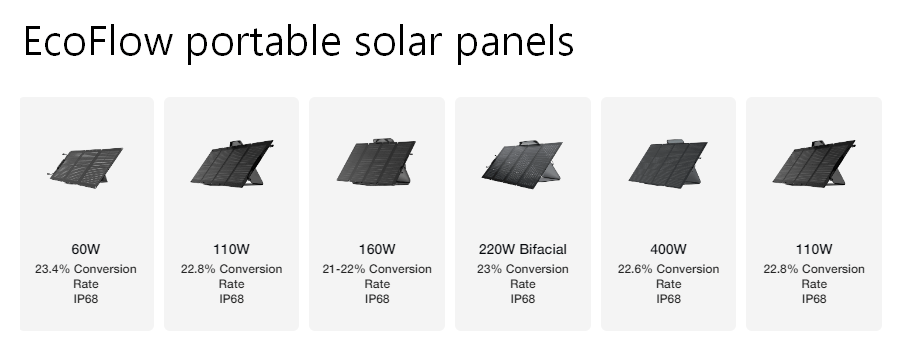
As mentioned above, many of BLUETTI’s portable solar panels have an IP65 rating, although they specify that the products shouldn’t be exposed to rainfall or submerged in water. It seems unreasonable to expect that you can keep your solar panels shielded from any rain droplets at all times, especially if you’re on a hike or out camping. A practical approach is to bring your solar panels indoors if rain seems likely, but don’t worry if they get a few drops on them before you can shelter them.
Choosing the right IP rating for your solar generators and panels
Choosing the right IP rating for your solar generator and portable solar panels ensures it matches the specific needs of the environment where you will likely be using it.
Here are some example scenarios and the minimum IP rating that would be recommended:
- Indoors: No specific IP rating required.
- Inside a dusty shed: Look for a solar generator with at least an IP6_ rating to ensure it is dust-tight (rather than just dust-resistant).
- In your garden: Theoretically, an IP54 rating should be appropriate as it offers protection against rain showers and garden sprinklers – but we would suggest looking for IP65 or more.
- On an RV road trip: Opt for rating of IP65 or higher, which can withstand exposure to dust or rain.
- Out camping: Again, opt for a rating of IP65 or above to ensure some protection against dust and rain.
- On the beach: An IP6_ rating is crucial as it ensures the device is dust-tight and completely protected against sand. An IP65 rating or above is recommended in the event of light splashes or rainfall.
- While fishing: An IP65 rating should be sufficient to protect against light splashes of water, but IP67 or IP68 would give even more peace of mind.
- On a boat: Look for IP67, IP68, or even IP69 to ensure your power station and solar panels have high protection against water. IP69 is the highest possible rating for both particles and water, so this would give you ultimate peace of mind.
Tips for maintaining IP integrity in solar panels and generators
Use conditions:
- Always use the devices within the environmental conditions specified by the manufacturer. Even if your devices have an IP rating which theoretically protects them against rainfall, always follow the manufacturer’s advice to ensure your warranty remains valid. In most cases, this means sheltering your power station or portable panels if it starts to rain.
- Portable power stations and solar panels will often have temperature ranges specified by the manufacturer. These may vary for storage and for active use. For power stations, there also many be varying ranges for discharge and charge, as well as a specific ‘best working temperature’.
Cleaning:
- Regularly clean your solar panels and generators using a soft, damp cloth to remove dust, dirt, and debris. Avoid using harsh cleaning agents or abrasive tools that can damage the surface and compromise the protective coating/seals.
- Check the product’s instruction booklet and warranty information for specific suggestions and guidelines around cleaning.
Maintenance:
- Inspect the seals and casings periodically for any signs of wear or damage. If you notice cracks or other imperfections, repair or replace the damaged parts promptly to maintain its IP rating.
- Ensure all coverings, caps, and protective shields are securely in place after any maintenance work or inspections.
- Check the product’s instruction booklet and warranty information for specific suggestions and guidelines around maintenance.
Storage:
- Store your solar devices in a cool, dry place with minimal dust when not in use.
- Check the product information for specific storage conditions, including appropriate temperature ranges.
- Some portable power stations have specific instructions not to lay the unit on its side for storage, for example, as this might affect its structural integrity.
- If storing for an extended period, make sure to charge the batteries of your solar generators to maintain battery health.
For further reading, you may be interested in:


